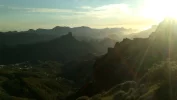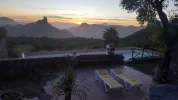Camino de Santiago on Gran Canaria 28-31 March
I have recently walked my shortest ever Camino - and one which I think will be amongst the most memorable of them. A little over three days spent walking a little over 73km from Maspalomas to Galdar on the island of Gran Canaria. Part of Spain but in the Atlantic Ocean only 100 miles or so from the Sahara desert. A great diversity of landscape: arid rocky plains, rough and steep mountains, and shady pine forests. A climb from sea level to over 1700m in just over 24 hours: followed almost immediately by a long long descent to the coast again!
The
Camino de Santiago on Gran Canaria is perhaps as distinctive for what it lacks as for what it offers: no albergues, no credencial, no Compostela, little accommodation, few bars or restaurants, comparatively limited signposting and virtually no pilgrims. The route is a fairly recent creation and makes use of an existing network of paths to connect the modern resort town of Maspalomas on the south coast with the historic church of Santiago in Tunte in the centre of the island. Along the way it passes through cactus-studded desert ravines and scrub, passes by a pre-Christian necropolis of rough stone burial mounds, then follows a dry river bed up into the mountains. From Tunte the route continues up and over the mountainous heart of the island, passing pre-Christian caves and a famous stone crucifix at Cruz de Tejeda before descending through forest and small villages to the original capital of the island at Galdar where the Church of Santiago shares the same papal privileges to grant indulgences to pilgrims as its rather more famous and visited Galician namesake. At least that was the plan. The signposting of the Camino is patchy and some of the published route information contradictory. That is my excuse anyway. On my third and supposedly final day of walking I missed the point where the Camino route parts company with another and better signposted path to Agaete - a smaller coastal town about 8km west of Galdar. By the time I realised my mistake it made sense to continue on the S90 path to Agaete and simply walk the last few km to Galdar by minor road on my final morning.
After a spectacular and frankly worrying steep descent into Agaete on my third evening I had the good fortune to find a very welcoming hostel in the town for a much needed shower and night's rest. I mentioned that there are no albergues for pilgrims along the route. Compared with the Spanish caminos low cost accommodation on the island is in very short supply. This is very much tourist Spain. There are more expensive options with luxury hotels in both Tunte and the Cruz de Tejeda but these did not suit either my pockets or my old-fashioned ideas of pilgrimage. Instead I decided to take advantage of the warm and mostly dry climate and spent two nights sleeping outdoors with a sleeping mat and a bivvy bag: enjoying marvellously clear skies, bright stars, and probably the most remarkable sunset over mountain and sea I have ever seen. A great privilege. I also carried more water and food than I would have done in mainland Spain since opportunities to buy food or refill water are very scarce. Although the Camino is only 73km - or a little more if navigationally-challenged like me! - the mountainous terrain, heat and lack of infrastructure makes it a serious undertaking. One for the more experienced and independent walker in my opinion. It lacks the historic character of routes like the Frances and the Primitivo where many centuries of pilgrim feet have prepared the way for the modern traveller. It is new and rough and raw. A challenge and a joy to walk.
http://www.grancanaria.com/patronato_turismo/EN.34317.0.html
http://www.grancanaria.com/…/t…/ext/naw_securedl/secure.php…
View attachment 33092
















